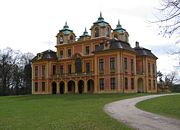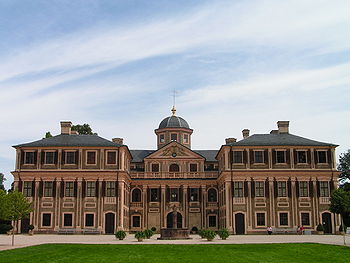
Lustschloss
Encyclopedia

Palace
A palace is a grand residence, especially a royal residence or the home of a head of state or some other high-ranking dignitary, such as a bishop or archbishop. The word itself is derived from the Latin name Palātium, for Palatine Hill, one of the seven hills in Rome. In many parts of Europe, the...
which served the private pleasure of its owner, usually the ruler of the area. It is located in, and was inhabited for court, ceremonial, and state duties.
A Lustschloss is often coupled with a Jagdschloss
Jagdschloss
A Jagdschloss is a palace or a castle in a zoo or a hunting zone such as a forest, field or lake and served primarily as the accommodation for a ruler, and the court, on the occasion of the hunt in the area....
. Both served as non-formal residences, but a Jagdschloss
Jagdschloss
A Jagdschloss is a palace or a castle in a zoo or a hunting zone such as a forest, field or lake and served primarily as the accommodation for a ruler, and the court, on the occasion of the hunt in the area....
was a hunting retreat and was mostly used to accompany a hunting party.

History
At the beginning of the RenaissanceRenaissance
The Renaissance was a cultural movement that spanned roughly the 14th to the 17th century, beginning in Italy in the Late Middle Ages and later spreading to the rest of Europe. The term is also used more loosely to refer to the historical era, but since the changes of the Renaissance were not...
, the wish for non-militaristic castles appeared in the nobility
Nobility
Nobility is a social class which possesses more acknowledged privileges or eminence than members of most other classes in a society, membership therein typically being hereditary. The privileges associated with nobility may constitute substantial advantages over or relative to non-nobles, or may be...
and they slowly left their old fortified castles, or altered them into homely residences. In the course of a few years, many of the noble families' seats grew up into big estates; at the same time the court ceremonial changed. Now the prince
Prince
Prince is a general term for a ruler, monarch or member of a monarch's or former monarch's family, and is a hereditary title in the nobility of some European states. The feminine equivalent is a princess...
stood more and more in the center of a luxurious royal household that reached its zenith during absolutism
Absolutism (European history)
Absolutism or The Age of Absolutism is a historiographical term used to describe a form of monarchical power that is unrestrained by all other institutions, such as churches, legislatures, or social elites...
. The nobility then surrounded themselves with artists, fawning courtiers, envoys, servants and petitioners. Often the residences overflowed with guests.
The wish for more intimacy led to the construction of the Lustschloss, to which often only certain circles of acquaintances had access. Here its owners could withdraw with their family and their relatives. At the Lustschloss one could devote himself to leisure or pleasure. The Lustschloss was above all, a place for parties, dancing and music. It often also was used for literature and painting. With it they formed the contrast to the real residence, which was often nearby. It served the state, in which etiquette had to be protected.
The most popular architectural styles of these particular castles were baroque
Baroque
The Baroque is a period and the style that used exaggerated motion and clear, easily interpreted detail to produce drama, tension, exuberance, and grandeur in sculpture, painting, literature, dance, and music...
and rococo
Rococo
Rococo , also referred to as "Late Baroque", is an 18th-century style which developed as Baroque artists gave up their symmetry and became increasingly ornate, florid, and playful...
which both displayed a sense of wealth. The Lustschloss was often located in a splendid schlosspark, mostly distinguished by especially extensive and valuable decorations. At the same time the rooms and drawing rooms became more intimate and more comfortable. Significant artists from their respective region would worked on many of their paintings in the castle. Famous examples are the Grand Trianon and the Petite Trianon in the gardens of Versailles
Versailles
Versailles , a city renowned for its château, the Palace of Versailles, was the de facto capital of the kingdom of France for over a century, from 1682 to 1789. It is now a wealthy suburb of Paris and remains an important administrative and judicial centre...
, and at the Castle Marly-le-Roi or the Amalienburg
Amalienburg
The Amalienburg is a small hunting lodge in the Nymphenburg Palace of Munich, southern Germany. It was constructed in 1734-1739 by François de Cuvilliés, in Rococo style, for the Holy Roman Emperor Charles VII and his wife, Maria Amalia of Austria....
in the schlosspark of Nymphenburg.
The name Lustschloss was often used interchangeably with the word Schloss
Schloss
Schloss is a German word for a building similar to a château, palace or manor house; or what in the British Isles would be known as a stately home...
, which is an unspecialized residential castle. The purpose of a Lustschloss also changed – it could be developed in the course of a few years and was remade into a castle which took over representative tasks. An example of this is Sanssouci
Sanssouci
Sanssouci is the name of the former summer palace of Frederick the Great, King of Prussia, in Potsdam, near Berlin. It is often counted among the German rivals of Versailles. While Sanssouci is in the more intimate Rococo style and is far smaller than its French Baroque counterpart, it too is...
, which was originally established as a summer house, and for a period of time, it delevoped into the main residence of Friedrich the Great of Prussia
Prussia
Prussia was a German kingdom and historic state originating out of the Duchy of Prussia and the Margraviate of Brandenburg. For centuries, the House of Hohenzollern ruled Prussia, successfully expanding its size by way of an unusually well-organized and effective army. Prussia shaped the history...
.
Some famous German Lustschlosses are Schloss Benrath
Schloss Benrath
Schloss Benrath is a Rococo maison de plaisance near Düsseldorf, Germany, erected for the Elector Palatine Charles Theodore by his garden and building director and garden supervisor, Nicolas de Pigage...
in Düsseldorf
Düsseldorf
Düsseldorf is the capital city of the German state of North Rhine-Westphalia and centre of the Rhine-Ruhr metropolitan region.Düsseldorf is an important international business and financial centre and renowned for its fashion and trade fairs. Located centrally within the European Megalopolis, the...
and Schloss Favorite
Favorite Ludwigsburg
Schloss Favorite is a Baroque maison de plaisance and hunting lodge in Ludwigsburg, Germany. It is located on a rise, directly north of Ludwigsburg Palace....
in Ludwigsburg
Ludwigsburg
Ludwigsburg is a city in Baden-Württemberg, Germany, about north of Stuttgart city centre, near the river Neckar. It is the largest and primary city of the Ludwigsburg urban district with about 87,000 inhabitants...
. The Lustschloss Favorite in Mainz
Mainz
Mainz under the Holy Roman Empire, and previously was a Roman fort city which commanded the west bank of the Rhine and formed part of the northernmost frontier of the Roman Empire...
had been destroyed during the siege of Mainz (1793).
See also
- BaroqueBaroqueThe Baroque is a period and the style that used exaggerated motion and clear, easily interpreted detail to produce drama, tension, exuberance, and grandeur in sculpture, painting, literature, dance, and music...
- :no:Lystslott
- :fr:Maison de plaisance
- :sv:Lustslott
- :de:Lustschloss

